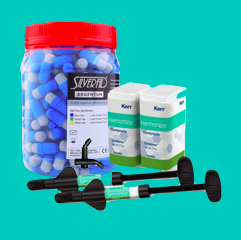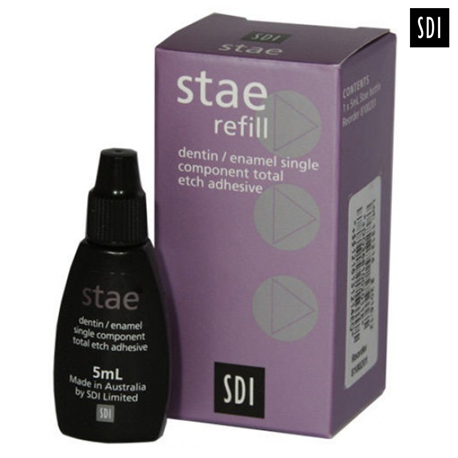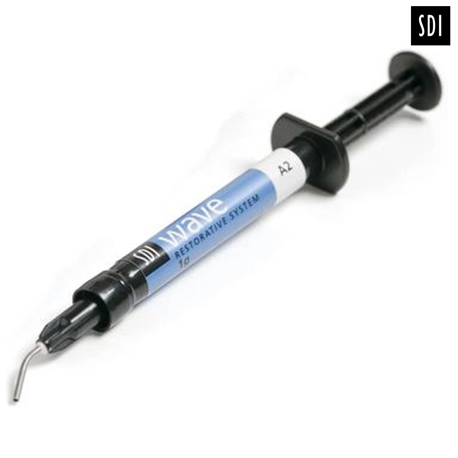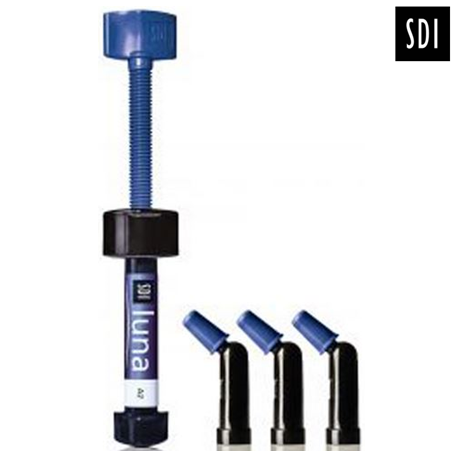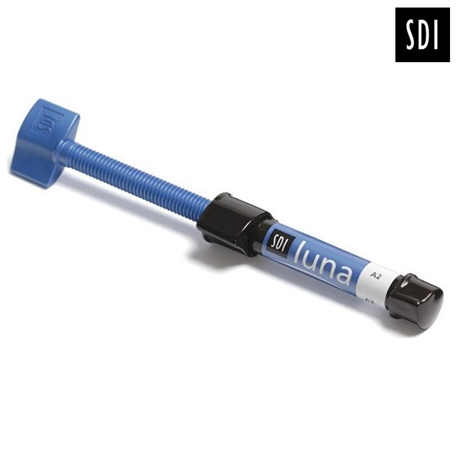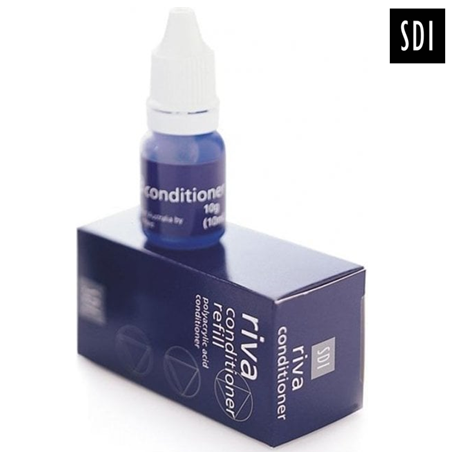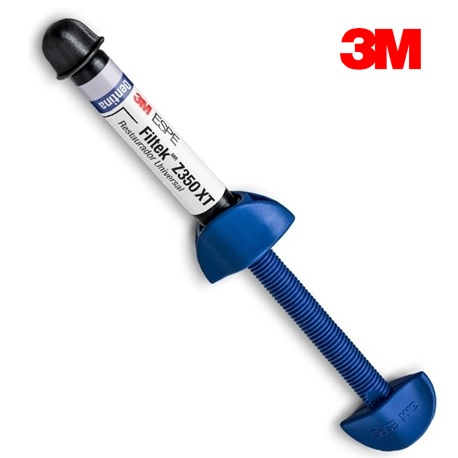Features :- One bottle system Stae combines both primer and adhesive in one bottle to simplify the technique and decrease patient chair time. Fluoride release Fluoride’s cariostatic effect enhances remineralization and inhibits enamel demineralization. In an aqueous environment, the fl uoride ions in Stae diffuse from the resin into the surrounding tooth. This ionic movement is caused by oral fl uid passing in and out of the resin and tooth, acting as a carrier for the fl uoride ions. Non Bis-phenol A Stae avoids the Bis-phenol A hormonal imbalance controversy, as it does not contain the related BisGMA resin. Bonds to moist and dry tooth surfaces Stae’s carrier solvent is a mixture of acetone and water. The acetone carries Stae deep into the demineralized dentin and the water re-moistens any dry dentin. High bond strength Stae’s complete hybridization of the resin into the demineralized dentin results in high bond strength. Key Specifications :- COMPOSITION: Acrylic monomer Acetone Fluoride Stabilizer Packaging :- 1 x 5ml Stae bottle Direction to Use :- 1. Clean and isolate tooth. Rubber dam is the preferred mode of isolation 2. Prepare a conservative cavity, employing standard techniques 3. Use a calcium hydroxide liner and appropriate glass ionomer cement liner to protect deep cavity preparations in close proximity to the pulp 4. Thoroughly dry the bonding surfaces of the tooth with dry, oil-free air 5. Etch with Super Etch 37% phosphoric acid (SDI Limited) for at least 20 seconds. NOTE: Enamel subjected to fluoridation should be etched for 90 to 120 seconds. IMPORTANT: If using an etch syringe, ensure that the dispensing tip hub is firmly attached to the syringe by twisting the hub securely onto the syringe. On first usage or after prolonged storage, extrude a small amount onto a mixing pad for familiarity with the etchant’s viscosity and rate of extrusion. 6. Wash thoroughly with water. 7. Remove excess water. Keep moist. Avoid contamination e.g. saliva. 8. Apply Stae to saturate all internal surfaces 9. Blow gently with dry, oil-free air to evaporate solvent. Leave surface glossy 10. Light cure for 10 seconds. NOTE: do not polymerize Stae by itself in a mixing well; it will be a non – polymerized looking material. Stae contains a unique hydrophobic and hydrophilic monomer that does not cure when exposed to oxygen. The product will polymerize once covered by any lightcure composite restorative material 11. Place composite in increments of 2mm or less.
Features Nanofilled Wave, Wave MV and Wave HV contain specially treated nano-fi llers to maximize polishability, wear resistance and strength. Ease of extrusion is improved with the addition of these specially treated nano-fi llers. Filler loading Wave, Wave MV and Wave HV all have excellent wear profi les due to their high fi ller loading level: Fluoride release Fluoride’s cariostatic effect enhances remineralization and inhibits enamel demineralization. In an aqueous environment, the fl uoride ions in Wave, Wave MV and Wave HV diffuse from the resin into the surrounding tooth. This ionic movement is caused by oral fl uid passing in and out of the resin and tooth, acting as a carrier for the fl uoride ions. Natural fluorescence Wave, Wave MV and Wave HV contain a fl uorescent agent that ensures perfectly natural looking teeth under ultraviolet lights. No one will know! Radiopacity Wave, Wave MV and Wave HV are all visible on x-rays. This allows easy identifi cation of secondary caries at the interface. Compressive strength Wave’s, Wave MV’s and Wave HV’s high compressive strength values expand the suitability for multiple applications. UDMA Wave’s UDMA resin system minimizes shrinkage and reduces post operative sensitivity. Tip length comparison Wave’s complet tip length is 12.2mm, 40% longer than the alternative of 8.7mm. Wave’s longer tip length allows more direct placement of the material into diffi cult to reach areas. Direction to Use Clean and Isolate tooth. A conservative cavity should be prepared, employing standard techniques and instruments, to form a slightly rounded internal form. Margins of the cavity preparation should end in sound and supported enamel with no bevels in stress bearing locations. If bevelling is desired in a low stress location it should extend no further than 1mm at an angle of no greater than 45°. Pre-wedging is also recommended to ensure that the restored tooth will have an adequate contact point. Prophy all surfaces to be etched including surfaces adjacent to the cavity with an oil free non-fluoride containing paste or a slurry of pumice and water. Rinse thoroughly with water. Shade Selection Shade selection should be made with a just cleaned and moist tooth. NOTE: Do not use uncured paste for color matching as there is a slight color change upon curing. Isolation Isolation techniques must be used to prevent contamination. Rubber dam is the preferred mode of isolation. Pulp Protection For deep cavities, use a calcium hydroxide liner and appropriate glass ionomer cement liner to protect deep cavity reparations in close proximity to the pulp. 1. Acid Etching Thoroughly dry the surface to be etched with dry, oil-free air. Etch tooth surface with Super Etch 37% phosphoric acid. (a) Enamel only Etch surface for at least 20 seconds (b) Dentin and enamel Using the “total etch” technique etch the surface including any glass ionomer for at least 20 seconds. Enamel subjected to fluoridation should be etched for 90 to 120 seconds. Etching Precautions: Ensure that the dispensing tip hub is firmly attached to the syringe by twisting the hub securely onto the syringe. Avoid acid contact with oral tissues, eyes and skin. If accidental contact occurs wash thoroughly with water. In the case of eye contact, wash eye for 15 minutes and seek medical attention. Use matrix strips to protect adjacent tooth surfaces during etching. On first usage or after prolonged storage, extrude a small amount onto a mixing pad for familiarity with the etchant’s viscosity and rate of extrusion 2. Wash thoroughly with water 3. Remove excess water. Keep moist. Avoid contamination e.g. saliva 4. Apply Stae dentin/enamel adhesive to saturate all internal surfaces, or bonding agent according to manufacturer’s instructions 5. Blow gently with dry, oil-free air for 2 seconds to evaporate solvent. Leave surface glossy 6. Light cure for 20 seconds (460-480nm wavelength, high power LED curing light) 7. Directly inject Wave in increments of 2mm or less in: 7.1 Class V restorations, 7.2 Tunnel preparations, 7.3 Pit and fissures sealants, 7.4 Minimal Class I, Class II, Class III and Class IV restorations. Or other indication as required. CAUTION: ensure that the dispensing tip is firmly attached to the syringe by twisting the tip hub securely onto the syringe.
Polyacrylic acid conditioner • Partially removes the smear layer • Optimises adhesion of the GIC • 26% polyacrylic acid
3M ESPE Filtek Z350 XT Flowable Restorative is a low-viscosity, visible light-cured, radio-opaque flowable nanocomposite. Provides natural aesthetics Superior nano-filler technology Wears natural Enamel look A high-performance, versatile nanocomposite. Excellent aesthetics for anterior restorations, strong enough for posterior restorations. Product Benefits: Lifelike aesthetics: - Excellent polish and polish rentention - Wide range of shades and opacities - Improved fluorescence Simple to Use: - Exceptional handling - More body shades for single-shade restorations - Capsules and syringes are color-coded by opacity - Bold, easy-to-read labels Unique nanofiller technology: - Better polish retention than a microfill - Wears better than leading competitors - Outstanding strength for anterior and posterior use "True" Nanotechnology 3M ESPE's unique nanofiller technology gives your restorations the best of strength and esthetics. Our nanocomposite is built from individual and unique clusters of nanometer-sized particles which are chemically bound within the matrix The nanoclusters shear at a rate similar to the wear of the surrounding resin matrix during abrasion The result is a smoother surface for long-term polish retention. Zircoia/Silica nanocluster Zirconia/Silica nanocluster: 100,000X magnification SEM: Dr. J. Perdigao, University of Minnesota Confidence that your anterior and posterior restorations will have a lasting, lifelike glossy appearance. With competitive nanohybrids larger particles wear differently, impacting polish retention. Filtek™ Supreme XTE Universal Restorative Venus Universal Restorative EsthetX HD Universal Restorative (l to r) Filtek™ Z350XT Universal Restorative, Venus Universal Restorative, EsthetX HD Universal Restorative Wear-resistance similar to enamel. Wear-resistance equal to Filtek Supreme Plus Universal Restorative¹ In a 5-year clinical study, Filtek Supreme Plus restorative showed it wears like enamel² ¹ In vitro data on file ² Katholic University Leuven – In vivo clinical study Wear Rate Filtek™ Supreme Ultra wear resistance similar to enamel Outstanding Strength Filtek™ Supreme Ultra outstanding strength Polish retention This optical analysis compares the surfaces of Filtek™ Z350XT Universal Restorative (Dentin, Enamel, Body shade) and a leading nano-optimized composite (right) after toothbrush abrasion.




